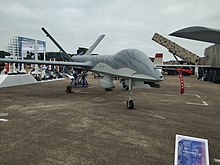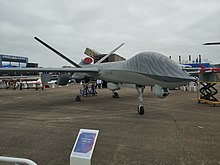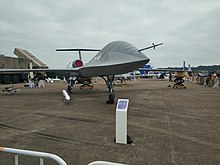CASC Rainbow (Cai Hong, abbreviated as CH) is a series of unmanned aerial vehicles (UAVs) developed by the China Academy of Aerospace Aerodynamics, an entity under the China Aerospace Science and Technology Corporation (CASC). The China Academy of Aerospace Aerodynamics is also known as the 11th Academy of CASC,[1] or 701st Research Institute.
Variants[edit]
This section contains content that is written like an advertisement. (October 2022) |
CH-1[edit]
CH-1 is the first of the Rainbow (CH) series UAVs. The general designer was Mr. Shi Wen (石文), who is also the general designer of CH-2, the successor of CH-1, CASC PW-1, the derivative of CH-1, and CASC PW-2, the derivative of CH-2. The CH-1 program began in 2000, and its success resulted in the establishment of the UAV program that led to other designs that followed. The CH-1 is mainly intended for reconnaissance and surveillance missions.[2]
Specification:[3]
- Wingspan (m): 4.4
- Length (m): 3.75
- Height (m): 0.87
- Weight (kg): 40
- Payload (kg): 4.5
- Fuel (kg): 26
- Max speed (km/h): 170
- Cruise speed (km/h): 120 – 150
- Normal radius (km): > 100
- Normal operating altitude (km): 1 – 3
- Ceiling (km): 4.6
- Max range (km): 740 @ 1 km altitude and 124 km/h speed
- Endurance (h): 6
- Rate of climb (m/s): 4.3
- Turn radius (m): 290
- g overload: - 1.5 to 3
- Launch: rocket assisted + catapult mounted on vehicle
- Recovery: parachute
- Max wind scale allowed for operation: 5
CH-2[edit]
CH-2 is the second of the Rainbow (CH) series UAVs and is a development of the earlier CH-1, with identical twin-boom layout. As for the CH-1, propulsion is provided by a two-blade propeller driven by a pusher engine mounted at the rear end of the fuselage, and the UAV is launched via vehicle mounted catapult with rocketed assisted take-off.[4][5] The CH-2 is mainly intended for reconnaissance and surveillance missions.[2]
CH-3[edit]
CH-3 is a fixed wing unmanned combat aerial vehicle (UCAV) of the Rainbow series. The CH-3 adopts an unusual canard layout, similar to the Jetcruzer 450 and the Rutan VariEze. This means that the CH-3 lacks centrally located vertical tail, but has large winglets and canards. Propulsion is provided by a three-blade propeller driven by a pusher engine mounted on empennage. The main landing wheels of the tricycle landing gear has fairing to reduce drag.[6]
In January, 2015, a CH-3 drone was reported to have crashed in the north of Nigeria.[7] It is believed the drone was involved in Nigeria's struggle against the militant group, Boko Haram.[8] China supplied the CH-3 to Nigeria government prior to 2014, along with YC-200 guided bombs and AR-1 air-to-ground missile.[9] In February, 2016, Nigeria announced a successful drone strike in its ongoing war against Boko Haram.[10]
China delivered 12 CH-3 to Myanmar in 2014-2015 to fight rebels.[11] NESCOM Burraq is thought to be mostly influenced by CH-3.[12]
Specification:[6]
- Wingspan (m): 8
- Range (km): 960
- Endurance (h): 12
- Payload (kg): 60 – 80
- Ceiling (km): 4
CH-3A[edit]
CH-3A is the development of CH-3 and share the identical layout. Improvement of CH-3A over CH-3 includes that the maximum payload is increased to more than 100 kg, and satellite data link is also incorporated. CH3A is a multipurpose UAV which can also carry AR 1 laser guided rocket for attacking role. It is also widely rumoured that Myanmar Air Force operates them, and some images have been found.
Specification:[13]
- Payload (kg): 180 maximum
- Endurance (h): 6 with maximum payload
- Ceiling (Km): 4
- Max Range (km): 960
CH-4[edit]
Externally, CH-4 looks almost identical to General Atomics MQ-9 Reaper, and the only distinct visual difference between two UAVs is that the ventral fin below the V-tail on MQ-9 is absent on CH-4.[14][15][16] There are two versions, the CH-4A and CH-4B. The CH-4A is a reconnaissance drone (capable of a 3500–5000 km range and a 30- to 40-hour endurance) while the CH-4B is a mixed attack and reconnaissance system with provisions for 6 weapons and a payload of up to 250 to 345 kg.
CH-4 is capable of firing air-to-ground missile from altitude of 5,000 meters (~16,400 feet), therefore the aircraft can stay outside of effective range of most anti-aircraft guns. It also allows CH-4 to be able to fire from a position that provides wider viewing area.[17]
Vasiliy Kashin, a China specialist at Moscow's Centre for Analysis of Strategies and Technologies, said that The CH-4B UCAV has been exported to Myanmar,[18][19] Pakistan, Egypt, Saudi Arabia, Algeria and Iraq.[20][21] Myanmar is also producing CH-4 UAV under license with the transfer of technology.[22]
Iraq has received an unknown number of CH-4B in early 2015, spurred on battlefield reversals in Mosul and Ramadi to ISIL.[23]
Saqr-1 is thought to be mostly influenced by CH-4.[24]
Specification:[25]
- Length: 8.5 m (28 ft)
- Wing Span: 18 m (59 ft)
- Max Take Off Weight: 1,300 kg (2,900 lb)
- Payload: 345 kg (761 lb)
- Endurance: 40 hours
- Powerplant: 1 x 1000 Hp engine
- Maximum Speed: 235 knots (435 km/h)
- Cruise Speed: 180 knots (330 km/h)
- Communications range: >1,000 km (620 mi) with SatCom (1,500-2,000 km for CH-4B),[26] ~150 km (93 mi) from Ground Control Station (GCS)
- Armaments: AR-1 missile, AR-2 missile (20 kg, 5 kg armour-piercing warhead, inertial guidance system with terminal semi-active laser (SAL) seeker, maximum range 8 km),[27] AKD-10 air-to-surface anti-tank missile, BRMI-90 90mm guided rocket, FT-7/130 130 kg glide bombs, FT-9/50 50 kg bomb, FT-10/25 25 kg bomb, GB-7/50 50 kg precision-guided munition (PGM), GB-4/100 PGM.[28]
CH-5[edit]
The CH-5 is the latest UCAV of the Rainbow series, with a wingspan of 21 metres, a payload of 1,000 kg, a maximum takeoff weight of over 3 tonnes, a service ceiling of 9 km, an endurance of up to 60 hours[29] and a range of 10,000 km. Thanks to shared data link it can cooperate with CH-3 and CH-4 drones. It conducted its maiden flight in August 2015[30] and its first airshow flight (in northern Hebei province) in July 2017.[29] The drone can carry 16 missiles at a single time. There were also plans to extend its range up to 20,000 km.[31] Chinese officials claimed the CH-5 Rainbow was similar in performance to the US MQ-9 Reaper and "may come in at less than half the price." Compared to the Garrett TPE331 turboprop engine mounted on the Reaper, CH-5 is equipped with an unidentified turbo-charged piston engine, with less than half the horsepower. This choice limits the maximum altitude of the CH-5 to 9 km compared to the 12–15 km of the Reaper, but it also extends CH-5's endurance to 60 hours compared to 14 hour of the Reaper's.
A newer variant with a 300kW piston engine from Anhui Hangrui Co. will increase the service ceiling to 12 km and endurance to 120 hours.[32]
Armaments: AR-1 missile, AR-2 missile (20 kg, 5 kg armour-piercing warhead, inertial guidance system with terminal semi-active laser (SAL) seeker, maximum range 8 km)[27]
CH-6[edit]
The CH-6 is a large UAV with a MTOW of 7800 kg with two variants: a strike variant with 18-hour endurance and 450 kg payload; a reconnaissance variant with 21-hour endurance and 120 kg payload. It was in development in 2021.[33]
CH-7[edit]
The CH-7 is a stealthy flying wing UCAV similar to the X-47B, with a 22m wingspan and 10m length. It can fly at 920 km/h and at an altitude of 13,000m. Endurance is about 15 hours and its operational radius is 2000 kilometers.[34] It can carry antiradiation missiles and standoff weapons.[35][36][37] According to its chief designer, "the CH-7 can intercept radar electronic signals, and simultaneously detect, verify and monitor high-value targets, such as hostile command stations, missile launch sites and naval vessels". It is planned to make its maiden flight in 2019 and commence production in 2022.[34]
CH-10[edit]
The CH-10 is a tiltrotor UAV.[38]
CH-91[edit]
CH-91 is a fixed-wing UAV in twin-boom layout with inverted v-tail and a pair of skids as landing gear. Propulsion is provided by a two-blade propeller driven by a pusher engine mounted at the rear end of the fuselage.[39][40] CH-91 is mainly intended for reconnaissance and surveillance missions.[2] It's also called as BZK-008.
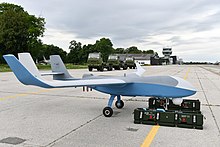
CH-92[edit]
CH-92 is a fixed-wing UAV in conventional layout with V-tail and tricycle landing gear. Propulsion is provided by a propeller driven by a pusher engine mounted at the empennage. CH-92 is mainly intended for reconnaissance, surveillance and attack missions.[2][41]
CH-802[edit]
CH-802 is a fixed wing micro air vehicle (MAV) in conventional layout with elevated high-wing configuration and V-tail. CH-802 has a cylindrical fuselage and propulsion is provided by a two-blade propeller driven by a tractor brushless electric motor atop of the fuselage.[42][43] CH-803 is mainly intended for reconnaissance and surveillance missions.[2] CH-802 program begun in 2007 and was completed in 2008.
- Wingspan (m): 3
- Length (m): 1.8
- Weight (kg): 6.5
- Payload (kg): 1
- Radius (km): 30
- Normal operating altitude (km): 0.3 – 1
- Normal radius (km): 30 – 50
- Cruise speed (km/h): 60
- Endurance (h): 2.5
- Ceiling (km): 4
- Launch: by hand
CH-803[edit]
CH-803 is a fixed-wing UAV with a cylindrical fuselage and canards, but without tailplane. Propulsion is provided by two-blade propeller driven by a tractor engine mounted in the nose. Another unique feature of CH-803 is that it adopts forward-swept wing.[44] CH-803 is mainly intended for reconnaissance and surveillance missions.[2] CH-803 program begun in 2008 and was completed in 2011.
Specification:[45]
- Wingspan (m): 3
- Length (m): 1.8
- Weight (kg): 18
- Payload (kg): 3.5
- Radius (km): 30
- Normal operating altitude (km): 0.5 – 1.5
- Normal radius (km): 50 – 80
- Cruise speed (km/h): 80 – 110
- Endurance (h): 5
- Ceiling (km): 3.5
- Launch: catapult
- Recovery: parachute
CH-817[edit]
VTOL micro-surveillance and attack UAV with a top speed of 64.8 km/hr and an endurance of 15 minutes.[46]
CH-901[edit]
CH-901 is a fixed-wing UAV in conventional layout with cylindrical fuselage and high-wing configuration. Propulsion is provided by a two-blade propeller driven by a pusher engine mounted at the end of empennage.[47] CH-901 is designed as an UCAV.[2][48]
CH-902[edit]
Fixed-wing cylindrical UAV.[49]
Operational history[edit]
Royal Saudi Land Force[edit]
The Kingdom of Saudi Arabia have been operating CH-4, along the Wing Loong II drone in its military intervention in Yemen.[50]
On 12 July 2018, Houthi rebels shot down an armed Saudi Arabian CH-4 drone near Asir border.[51][52]
On 8 August 2018, Houthi rebels shot down an armed Saudi Arabian CH-4B drone near Tuwal border crossing.[53][54]
On 23 December 2018, Houthi rebels shot down a Saudi Arabian CH-4 drone.[55] in Saada province, northern Yemen and displayed the wreckage of the drone.[56][57]
On 11 April 2019, a Saudi Arabian CH-4 drone is lost over Yemen, according to Houthi media the Saudi drone was shot down by friendly fire.[58][59]
On 7 January 2020, Houthi rebels shot down an armed Saudi Arabian a CH-4B drone over Jawf province.[60][61]
On 22 December 2020, Houthi rebels shot down a Saudi Arabian CH-4B drone, serial number 20311 on the district of Madghal in Marib province.[62][63][64]
On 12 February 2021, Houthis intercepted a Saudi Arabian CASC Rainbow CH-4 drone in Meghdal, Marib Governorate, displaying footage of the shot down.[65][66]
On 23 March 2021, a Houthi spokesman said that Houthi forces shot down a US MQ-9 Reaper drone operating in Marib,[67] however a day later the Houthis published footage of the shootdown depicting a drone resembling a CH-4 drone.[68][69]
On 23 May 2021, a Saudi Coalition CH-4 drone is shot down by Houthi fighters in Al-Maraziq, Al-Jawf governarate.[53][70] Later Houthi media wing released a video of the shotdown of the drone.[71]
On 6 October 2021, Houthis reported the shot down of a Saudi Arabian CASC Rainbow CH-4 drone in Juba district,[72] southern Marib province by Houthi Air Defenses, later displaying footage of the drone wreck.[73][74]
United Arab Emirates Air Force[edit]
The United Arab Emirates Air Force have been operating CH-4, along the Wing Loong II drone in its military intervention in Yemen.[50][75]
Comparison[edit]
| Model | Manufacturer | Armaments | Takeoff weight | Engine type | Maximum cruise speed | Operational endurance |
|---|---|---|---|---|---|---|
| CH-1 | CASC | No | 220 kg | Piston | 140 km/h | 6 hours |
| CH-2 | CASC | No | 220 kg | Piston | 160 km/h | 8 hours |
| CH-3 | CASC | Yes, 80 kg | 650 kg | Piston | 220 km/h | 12 hours |
| CH-4 | CASC | Yes, 345 kg | 1330 kg | Piston | 180 km/h | 30 hours for recon / 12 hours for strike |
| CH-5 | CASC | Yes, 1000 kg | 3300 kg | Turboprop | 220 km/h | 60 hours for recon / 30 hours with 8 AR-1 missiles |
| GJ-1 (Wing Loong 1) | Chengdu | Yes, 200 kg | 1100 kg | Piston | 280 km/h | 20 hours |
| GJ-2 (Wing Loong 2)[77] | Chengdu | Yes, 480 kg | 4200 kg | Turboprop | 370 km/h | 32 hours / 20 hours at max speed |
| Wing Loong 3[78] | Chengdu | Yes, 2300 kg | 6200 kg | Turboprop | Unknown | 40 hours |
| Chengdu WZ-10 | Chengdu | Yes, 400 kg | 3200 kg | Turbojet | 370 km/h | 32 hours |
| WJ-700[79] | CASIC | Yes | 3500 kg | Turbofan | Unknown | 20 hours |
| WJ-600 A/D[80] | CASIC | Yes | Unknown | Turbofan | 850 km/h | 5 hours |
| TB-001A[81] | Tengdeng | Yes, 1200 kg | 3200 kg | Turboprop | Unknown | 35 hours at 1000 kg payload |
Operators[edit]
- Algerian People's National Armed Forces: CH-3 and CH-4[82]
- Indonesian Armed Forces: six CH-4Bs[27][84][26]
- Iraqi Armed Forces: 14 CH-4B[85][86][87][88]
- Myanmar Air Force: Acquired 12 CH-3As and some CH-4s for precision airstrike mission.[89][90][83][91] Myanmar is also producing CH-4 with the transfer of technology under license.[92]
- Nigerian Air Force: CH-3[9]
- Pakistan Armed Forces: Known to use CH-3 inspired UCAVs like the GIDS Shahpar since 2012.[93] Procured 12-24 CH-4A/B UCAVs in late January 2021.[94][95]
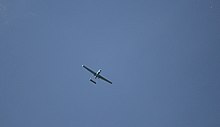
- Serbian Air Force and Air Defence: 6 CH-92A[96]
- Turkmen Air Force: 3 3 CH-3[97]
- United Arab Emirates Armed Forces: CH-4 [83]
See also[edit]
Related lists
References[edit]
- ^ "中国航天科技集团公司第十一研究院" (PDF) (in Chinese). August 21, 2014. Archived from the original (PDF) on 2014-08-21.
- ^ a b c d e f g "Rainbow (CH) UAVs". Archived from the original on 2013-01-27. Retrieved 2012-11-12.
- ^ "CH-1". Archived from the original on 2013-11-21. Retrieved 2013-11-21.
- ^ "CH-2". Archived from the original on 2015-06-12. Retrieved 2013-11-21.
- ^ "中国无人攻击机曝光 亚洲某国已大批购买_新闻滚动_大成网_腾讯网".
- ^ a b "CH 3 & 3A". Retrieved 2008-11-08.
- ^ "It Seems a Chinese Missile Drone Just Crashed in Nigeria". Medium. 28 January 2015.
- ^ "Did An Armed Chinese-Made Drone Just Crash in Nigeria?". Popular Science. 28 January 2015.
- ^ a b "CH-3 fighting in Nigeria". Archived from the original on 2018-10-08. Retrieved 2014-12-29.
- ^ "Watch Nigeria's First Confirmed Drone Strike". 18 March 2019. Retrieved 2019-11-21.
- ^ "Myanmar armed forces use Chinese armed drones to fight rebels in the country | January 2020 Global Defense Security army news industry | Defense Security global news industry army 2020 | Archive News year". www.armyrecognition.com.
- ^ "'Significant development': Pakistan deploys first homemade drone, kills three militants". The Times of Israel. 2015-09-07. Retrieved 2019-11-29.
- ^ "CH-3A". Archived from the original on 2013-04-05. Retrieved 2013-11-21.
- ^ "航展国产无人机抢先看:彩虹系列可用于战场侦察及反恐作战【2】--军事--人民网". Archived from the original on 2013-12-16. Retrieved 2013-11-21.
- ^ "Red dawn: Communist China stepping up drone deployment,"The Washington Times, March 26, 2013
- ^ "China's CH-4B Drone Looks Awfully Familiar to a U.S. Drone". Popular Mechanics. July 28, 2016.
- ^ "CH-4 firing from high altitude". AirForceWorld.com. Archived from the original on 2015-05-02. Retrieved 2015-05-06.
- ^ United Nations Human Right Office of the High Commissioner, OHCHR (August 2019). "Arms and Military Equipment Suppliers to the Tatmadaw" (PDF). United Nations. Archived (PDF) from the original on 23 October 2020.
- ^ Weinberger, Sharon (10 May 2018). "China Has Already Won the Drone Wars". Foreign Policy. Archived from the original on 22 October 2020.
- ^ "China Again Tries To Pierce Gulf Defense Market". defensenews.com. 6 November 2015.
- ^ "中国彩虹4B无人机在中东显威 专家却这样说". sohu.com (in Chinese). Archived from the original on 2015-11-17. Retrieved 2015-11-14.
- ^ United Nations Human Right Office of the High Commissioner, OHCHR (August 2019). "Arms and Military Equipment Suppliers to the Tatmadaw" (PDF). United Nations. Archived (PDF) from the original on 23 October 2020.
- ^ "China helps Iraq military enter drone era". BBC. 12 October 2015.
- ^ "Saudi Arabia's First Domestic Long-distance UAV Fires Only Chinese-made Missiles and Bombs". 2017-05-14. Retrieved 2019-11-29.
- ^ "China May Have Executed Large Order for CH-4 Drones". Defense World. 29 April 2020. Retrieved 18 October 2020.
- ^ a b "Indonesian Air Force's fleet of CH-4 UAVs granted airworthiness approval". Janes.com. Retrieved 2021-09-03.
- ^ a b c "Indonesia receives first batch of Chinese-made AR-2 missiles for its CH-4 UAVs".
- ^ "Saudi Arabia".
- ^ a b Fullerton, Jamie (2017-07-18). "China's new CH-5 Rainbow drone leaves US Reaper 'in the dust'". The Times. Retrieved 2017-07-18.
- ^ "国产最大察打一体无人机"彩虹"5号首飞成功" [China's biggest success with unmanned aerial vehicle "Rainbow" on the 5th flight]. Phoenix News (in Chinese). China. 2015-08-30. Retrieved 2017-07-18.
- ^ Lei, Zhao (2016-11-01). "Unmanned combat drone to be exported". China Daily. Retrieved 2017-07-18.
- ^ Mathew, Arun (2017-07-16). "Production variant of China's CH-5 drone completes trial flight". defpost.com. Archived from the original on 2017-10-01. Retrieved 2017-09-30.
- ^ Wong, Kelvin (27 September 2021). "Airshow China 2021: CASC's twin-turbofan CH-6 armed reconnaissance UAV prototype breaks cover". Janes. Retrieved 16 May 2022.
- ^ a b "Stealth drone about to hit world market - Chinadaily.com.cn". www.chinadaily.com.cn.
- ^ "China steps up drone race with stealth aircraft". The Straits Times. November 10, 2018.
- ^ @writetake (November 8, 2018). "Here's China's gen-next stealth combat aircraft #CH7 with a wingspan of 22-m and 10-m long. It has a cruise altitud…" (Tweet) – via Twitter.
- ^ "Airshow China 2018: CASC reveals stealth UCAV development | Jane's 360". www.janes.com.
- ^ "China reveals CH-10 tilt-rotor drone - Headlines, features, photo and videos from ecns.cn|china|news|chinanews|ecns|cns". www.ecns.cn. Retrieved 2021-05-10.
- ^ "CH-97". Archived from the original on 2013-12-16. Retrieved 2013-11-21.
- ^ "实拍珠海航展:零距离接触中国无人机家族_图片频道_新华网". November 17, 2012. Archived from the original on 2012-11-17.
- ^ "实拍珠海航展:零距离接触中国无人机家族_图片频道_新华网". November 18, 2012. Archived from the original on 2012-11-18.
- ^ "CH-802 UAV". Archived from the original on 2013-12-16. Retrieved 2013-11-21.
- ^ "实拍珠海航展:零距离接触中国无人机家族_图片频道_新华网". November 18, 2012. Archived from the original on 2012-11-18.
- ^ a b "CH-802 & 803". Retrieved 2010-11-06.
- ^ a b "CH-802 and 803". Archived from the original on 2013-12-16. Retrieved 2013-11-21.
- ^ Wong, Kelvin (1 October 2021). "Airshow China 2021: CASC unveils CH-817 micro-surveillance and attack VTOL UAV". Janes. Retrieved 16 May 2022.
- ^ "CH-901". Archived from the original on 2013-12-16. Retrieved 2013-11-21.
- ^ "实拍珠海航展:零距离接触中国无人机家族_图片频道_新华网". November 19, 2012. Archived from the original on 2012-11-19.
- ^ "UAVs shown in Airshow China (16) - People's Daily Online".
- ^ a b "Pentagon is scrambling as China 'sells the hell out of' armed drones to US allies". CNBC. 21 February 2019.
- ^ "Wing Loong I ? CH-4B ? Un drone armé saoudien " abattu " près du Yémen". July 15, 2018.
- ^ "CASC CH-4В Cai Hong 4 (Rainbow)". July 12, 2018.
- ^ a b "Infographic: How many CH-4 drones were shot down by Ansar Allah?". Islamic World News. 24 May 2021.
- ^ "إسقاط طائرة بدون طيار تابعة للعدوان في جيزان". Almanar (in Arabic). 30 August 2018.
- ^ "Yemeni rebels claim they shot down Saudi-led coalition drone". www.efe.com.
- ^ "Houthis display coalition CH-4 plane downed in Jawf". Debriefer. 17 January 2021.
- ^ "Saudi drone shot down in Yemen". Times of Islamabad. December 23, 2018.
- ^ "The Saudi coalition downed a drone in Yemen. Then the accusations flew". Wired. 14 October 2019.
- ^ Lost Armour (11 April 2019). "CASC CH-4В Cai Hong 4 (Rainbow)".
- ^ "Saudi CH-4 drone shot down by Yemeni air defnces in Jawf |". Al-Thawra Net.
- ^ "Video footage of downing Saudi CH-4 drone released". January 7, 2020. Archived from the original on 15 January 2020.
- ^ "CASC CH-4B Cai Hong 4 (Rainbow)". 22 December 2020.
- ^ "Yemen rebels: Fighters shot down Saudi-run drone near border". The Washington Post. 22 December 2020. Archived from the original on 5 January 2021.
- ^ "Houthis Claim Saudi CH-4 Drone Downed Near Border". The Defense Post. 23 December 2020.
- ^ "SAM "Osa" shot down a strike drone of Saudi Arabia". avia-pro.net. 13 February 2021.
- ^ "War media distributes footage to shoot down CH-4 fighter plane in Marib". Yemen News Agency. 12 February 2021.
- مأرب - مشاهد للحظة اطلاق واصابة الطائرة التجسسية المقاتلة من نوع "CH4" في مديرية #مدغل. الإعلام العسكري. February 12, 2021 – via YouTube.
- ^ "US warplane downed in Yemeni Marib: Houthis". Debriefer. 23 March 2021.
- ^ "Houthi forces release video of alleged missile hitting US-made MQ-9 reaper drone". Almasdar. 26 March 2021.
- ^ "CASC CH-4B Cai Hong 4 (Rainbow)". Lost Armour.
- ^ "Yemeni Forces Shoot Saudi Drone in Jawf Skies". Alwaght News and Analysis. 23 May 2021.
- ^ "Yemeni army shoots down Saudi spy drone in Al Jawf". Mehr News Agency. 23 May 2021.
- ^ "(Statement) Houthi Elements (Ansarallah) Successfully Shot Down a Saudi Owned CH-4 Reconnaissance and Surveillance Drone Using a Missile in Juba District, Marib Governorate, Yemen - 6 October 2021". Terrorism Research Analysis Consortium.
- ^ "Yemen: Ansar Allah destroyed the tenth CH-4 drone". Islamic World News. 6 October 2021.
- ^ "The Houthis announce the downing of a Saudi march northeast of Sanaa". Dearborn. 5 October 2021.
- ^ Li, Christina (1 April 2017). "UAE's Increasing Role in China's Security Calculus" (PDF). ISPSW Strategy Series: Focus on Defense and International Security.
In Yemen, the UAE is already using China's Wing Loong drones in its campaign against al Qaeda, and recently purchased the CH-4 drones
- ^ "Is China at the Forefront of Drone Technology?". 29 May 2018.
- ^ Administrator. "Wing Loong II 2 UAV MALE armed drone data pictures video | China Chinese unmanned aerial ground systems UK | Chinese China army military equipment armoured UK". www.armyrecognition.com. Retrieved 2022-11-13.
- ^ "Chinese defense aviation industry unveils its new Wing Loong 3 UAV at AirShow China 2022 | Defense News November 2022 Global Security army industry | Defense Security global news industry army year 2022 | Archive News year". www.armyrecognition.com. Retrieved 2022-11-13.
- ^ "Chinese CASIC WJ-700 UAV makes maiden flight". www.airrecognition.com. Retrieved 2022-11-13.
- ^ "航展新闻眼:航天科工"无人机" 高隐身 高速度 可侦察 可打击-新闻频道 | 珠海网". web.archive.org. 2015-02-23. Retrieved 2022-11-13.
- ^ "Three-engined variant of China's Tengden TB001 UAV makes maiden flight". Janes.com. Retrieved 2022-11-13.
- ^ "Algeria, Egypt unveil chinese uavs". defenceweb.co.za. 2 November 2018.
- ^ a b c d "China Has Already Won the Drone Wars". Foreign Policy. 10 May 2018.
- ^ Ridzwan Rahmat (7 October 2019). "Indonesia showcases CH-4 UAVs at military parade". janes.com. Jane's Defense Weekly. Retrieved 2 January 2020.
- ^ "Janes | Latest defence and security news". Janes.com.
- ^ "Rainbow UAV gives Iraq new spectrum abilities". Flight International: 21. 20 October 2015.
- ^ "CH-4 drone in Iraq – The Diplomat". thediplomat.com.
- ^ "The Iraqi Media after the US-Led Invasion", Media Practice in Iraq, Palgrave Macmillan, 2012, doi:10.1057/9781137271648.0010, ISBN 9781137271648, retrieved 2022-09-18
- ^ Ankit panda (9 June 2016). "Is Myanmar Using Armed Chinese Drones For Counterinsurgency?". Archived from the original on 3 August 2020. Retrieved 9 June 2016.
- ^ Panda, Ankit. "Is Myanmar Using Armed Chinese Drones For Counterinsurgency?". thediplomat.com. Retrieved 2022-09-18.
- ^ "Myanmar armed forces use Chinese armed drones to fight rebels in the country". www.armyrecognition.com.
- ^ United Nations Human Right Office of the High Commissioner, OHCHR (August 2019). "Arms and Military Equipment Suppliers to the Tatmadaw" (PDF). United Nations. Archived (PDF) from the original on 23 October 2020.
- ^ "آیا پهپادهای رزمی پاکستان در عملیات طالبان در پنجشیر شرکت داشتند؟".
- ^ "Pakistan procures CASC Rainbow (CAI HONG) CH-4 Unmanned Aerial Vehicle (UAV)". PakStrategic.com. 29 January 2021.
- ^ "China unveils new drones aimed at buyers in developing countries". The World from PRX. Retrieved 2022-09-18.
- ^ Banković, Živojin. "[VIDEO] Na Batajnici prikazane kineske izviđačko-borbene bespilotne letelice CH-92A, kupljeno 6 letelica sa 18 raketa" (4 July 2020). Tango Six. Retrieved 6 July 2020.
- ^ "КИТАЙ НА МАРШЕ. О ЧЕМ ГОВОРИТ АВИАСАЛОН В ЧЖУХАЕ. Часть 1" (in Russian). Retrieved 2022-09-18.
